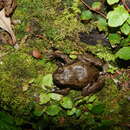Brief Summary
provided by IABIN
Diagnosis Medium-sized frog, adults 32 to 46 mm, plump build with short, blunt snout; head as broad or slightly broader than long; vomerine teeth in two straight or slightly oblique groups well behind the posterior margin of the choanae; first finger shorter than second; toes with only a rudiment of web; subarticular tubercles prominent and conical; usually a heel tubercle; no tarsal ridge; skin of adults shagreened; middle ear present, tympanic annulus usually visible externally; mature males with large nuptial pads on dorsal surface of first and second fingers and with paired internal vocal sacs.
- author
- Esteban O. Lavilla
- editor
- Diego Arrieta
Distribution
provided by IABIN
Known from 38°S to 40°S in Cautín and Valdivia Provinces, Chile,
- author
- Esteban O. Lavilla
- editor
- Diego Arrieta
Molecular Biology
provided by IABIN
flavonóides, saponósidos, esteroides, triterpenos, óleo essencial (alfa pineno) (20)
Diagnostic Description
provided by IABIN
Adult morphology Plump habitus. Tongue broadly rounded, its posterior 1/2 is free and with only a faint indication of a notch; a very narrow, inconspicuous seam forming a frill round the edge of the tongue. Vomerine teeth in two, strong, oblique groups well behind the posterior borders of the semicircular choanae and separated from each other by a distance equal to 1 1/2 times the width of one of the choanae. Snout fairly long, rounded in dorsal view, in profile slanting backwards towards the lip border and distinctly rounded, almost equal to the horizontal diameter of the eye. The upper jaw barely extends beyond the lower jaw. Nares dorsolateral, slightly projecting, the distance between the middle of the nares equal to the width of the interorbital space which is as broad as the upper eyelid, their distance from the anterior borders of the eyes about equal to their distance from the tip of the snout. Canthus rostralis curved and prominent; loreal region concave and oblique with upper lip flaring out below; eye large and prominent, not projecting beyond the jaws in dorsal view. Middle ear apparatus complete; the tympanic annulus conspicuous externally, its diameter 1/2 the eye width; Tibiotarsal articulation of the adpressed hind limb reaches to the anterior border of the eye. Fingers free of web, first finger shorter than second, subarticular tubercles moderate. Tips of fingers and toes rounded, with simple terminal phalanges. Toes rounded without webbing but metatarsals partially separated by web. A large elongate inner, and a small, rounded outer metatarsal tubercle present; supernumerary metatarsal tubercles absent; subarticular tubercles well developed; a small heel tubercle present. Skin on upper parts of body shagreened with thickened, slightly pitted area m the paratoid region and at the corners of the mouth. A pronounced glandular, dorsolateral fold extends from the posterior edge of the eyelid, passes above the tympanum and posteriorly to midway between the arm and the leg insertion. Ventral surface smooth, except for a granular area around the vent and on the insides of the thighs; limbs smooth. Dorsum with a conspicuous light patch on forehead, a dark triangular mark in post interorbital area and posteriorly an indistinct hour-glass pattern; dark patches on either side of the lumbar region. Hind limbs cross barred; venter immaculate. Mature males have paired internal vocal sacs opening on the floor of the mouth in wide slits. The nuptial pads present on the first and second fingers consist of clusters of fine brown spinules, are restricted to the dorsal surface and extend to the bases of the distal phalanges. The inner palmar tubercle also bears asperities which like those on the fingers are granular. Larval morphology Development stages 33 through 44 of Gosner (1960). The largest specimen (stage 40) of this serie (11 tadpoles) has total length 19.3 mm, body length 7.2 mm and tail length 12.1 mm. The distance eye-base of tail/distance eye-snout ratio is 3.6. The smallest tadpole (stage 33) has a body length 6.1 mm, a total length 17.5 mm and a tail length 11.4 mm. Body ovoid in lateral view, two times longer than deep; dorsal contour gradually curved from middle of body to snout. Eyes large, separated by a distance 1.3 times the eye diameter, directed anterodorsolaterally. Nostrils small, closer to tip of snout than to the eyes. Mouth small, anteromedial, labial papillae interrupted anteriorly, few denticles on tooth rows; tooth rows 2/2. Beak well developed. Large anal tube medial; no spiracle, a small fissure midway on the left side of the body. Caudal musculature moderately robust, dorsal and ventral fins well developed; end of tail rounded. Dorsal fin beginning midway on body. Color in life white-creamy, abdomen and fins transparent, internal organs visible. Minute melanophores are disposed on dorsal area. Color in formalin similar to that in life.
- author
- Esteban O. Lavilla
- editor
- Diego Arrieta
Behavior
provided by IABIN
AMÉRICA DO SUL, AMÉRICA DO NORTE
Eupsophus roseus: Brief Summary
provided by wikipedia EN
Eupsophus roseus, the rosy ground frog, is a species of frog in the family Alsodidae. It is endemic to Chile. Its natural habitats are temperate forest, rivers, swampland, and intermittent freshwater marshes. It is threatened by habitat loss.
- license
- cc-by-sa-3.0
- copyright
- Wikipedia authors and editors

